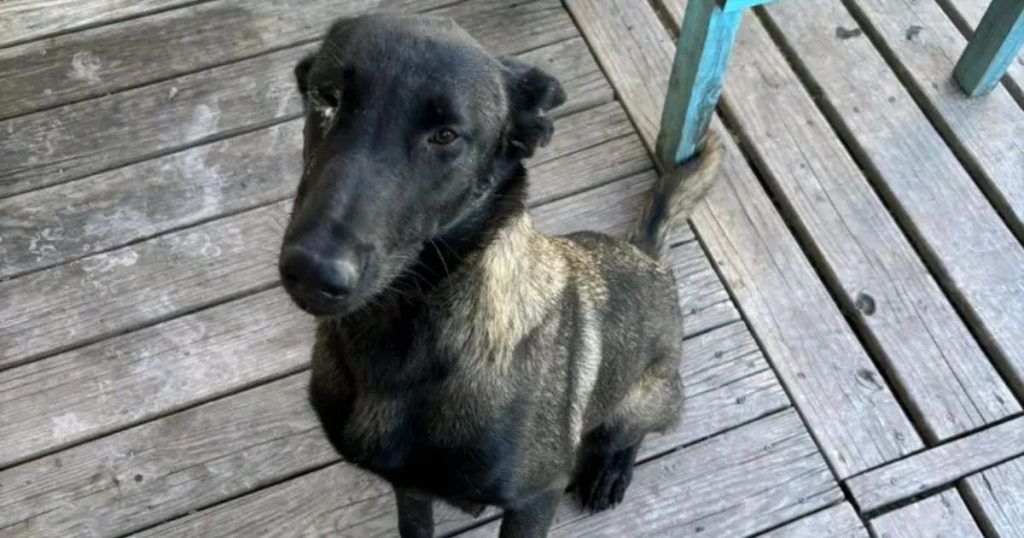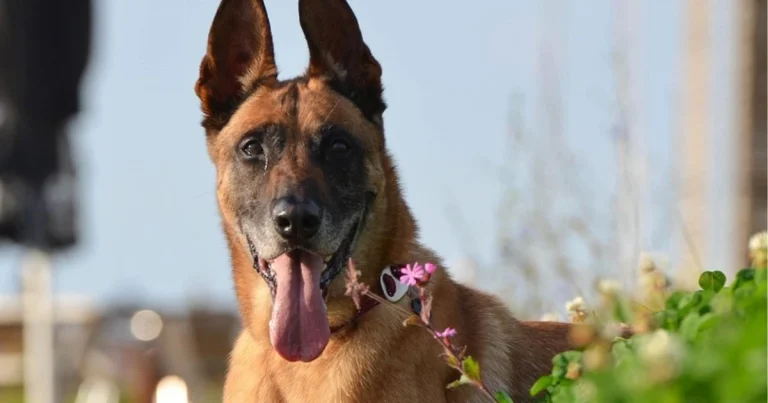Black Belgian Malinois: Unique Traits and Characteristics of This Rare Coat Color
Table of Contents
Black Belgian Malinois
The Black Belgian Malinois is a standout among dog breeds. Its all-black coat is rare, unlike the common fawn-and-tan color. This breed is powerful and elegant, making great loyal companions. They have lots of energy and focus.
Thinking of getting one? Knowing their unique traits is key to a great match. Their sleek look is just the start. Their behavior, health, and care needs are also important.
This article dives into how their coat affects their behavior and health. It shows why owning a Black Belgian Malinois is more than just a pretty face. It’s about history, genetics, and what owners need to know.
Key Takeaways
- Black Belgian Malinois are a rare coat variant of the belgian malinois breed.
- Genetics play a major role in their all-black coloring and athletic build.
- Owners must plan for daily exercise and mental challenges due to their high energy.
- Early training and socialization shape their behavior and adaptability.
- Proper care requires attention to their unique grooming and health needs.
Unveiling the Mystery: What Sets the Black Belgian Malinois Apart?
The Black Belgian Malinois has a unique look and belgian malinois temperament thanks to genetics and environment. Their coat color is eye-catching, but their lineage reveals their special traits.
Distinctive Coat Characteristics
Black Belgian Malinois are rare because of their special coat genetics. Their short, dark coats show certain genes that affect their looks and health. Key traits include:
- Dense, weather-resistant undercoat
- Jet-black fur with minimal fading over time
- Distinct facial masks and expressive eyes

Genetic Background and Ancestry
These dogs come from herding stock in Belgium. Selective breeding focused on their utility and toughness. A table shows how genetics shape their traits:
| Gene | Temperament Link |
|---|---|
| Melanistic gene variants | Enhanced alertness and energy |
| Herding breed markers | Strong work drive and focus |
“Genetic diversity in Belgian Malinois directly impacts their behavior, balancing instinct with trainability,” notes the American Kennel Club’s breed analysis.
Knowing these connections helps owners see how the belgian malinois temperament fits their historic roles. This mix of heritage and science makes them both beautiful and purposeful pets.
Understanding Your Black belgian malinois Temperament
Managing a Black Belgian Malinois’ temperament requires focus on their drive and smarts. They need structured guidance, starting early. Training is key to turning their instincts into good habits.
Behavioral Insights and Training
Belgian malinois puppies are full of energy and love to please. Start training them right away with simple commands like “sit” and “stay.” Use positive reinforcement like treats or praise to encourage good behavior. It’s important to be consistent and mix training with play.
- Early obedience training prevents behavioral issues.
- Focus on mental stimulation through puzzle toys or scent games.
- Avoid harsh corrections; rely on rewards to build trust.
Socialization and Interaction Tips
Socialization is key to how your dog interacts with the world. Introduce them to new people, animals, and places every week. This helps them not be scared or aggressive later.
| Early Socialization | Delayed Socialization |
|---|---|
| Builds confidence and trust | Potential for anxiety or aggression |
| Easier adaptation to change | Resistance to new experiences |
| Stronger human-animal bond | Difficulty forming trust |
Regular walks in parks or puppy classes are great for socializing. Their protective nature means you should watch them around strangers. But, early exposure helps them know who’s a threat and who’s not.
Caring for Your Dog’s Unique Needs
Keeping your Black Belgian Malinois healthy means tailoring care to their needs. Their thick coat and love for activity require regular grooming and health checks. Like the belgian sheepdog, they do well with consistent care to prevent common issues.
Grooming and Maintenance Essentials
Weekly grooming is key to a shiny coat. Follow these steps:
- Brush 2–3 times weekly to reduce shedding
- Bathe every 2–3 months unless muddy or dirty
- Trim nails every 4–6 weeks to prevent overgrowth
- Wipe ears weekly with a vet-approved cleanser
Health Monitoring and Veterinary Care
Regular vet visits are essential for a long life. Keep an eye on these important areas:
| Health Focus | Key Actions |
|---|---|
| Joint Health | Yearly x-rays to screen for hip dysplasia |
| Eye Care | Annual eye exams for conditions like progressive retinal atrophy |
| Genetic Screening | Request DNA tests for hereditary diseases common in belgian sheepdog relatives |
Note: If your dog needs a diet change, talk to a certified canine nutritionist. Always keep up with heartworm and flea prevention.
A Deep Dive into Belgian Malinois Puppies Care
Raising a Belgian Malinois puppy needs special care to help them grow into a malinois belgian shepherd. These dogs do best when they get lots of confidence and health in their early months. Start with plans that help their future behavior and health.
Early Socialization Strategies
Start by slowly introducing puppies to new things. Begin at 8 weeks with:
- Quiet and loud environments (e.g., vacuum cleaners, traffic sounds)
- Various textures (grass, carpet, stairs)
- Positive interactions with children and other pets
“Puppies learn what’s ‘normal’ during their first four months. Missing this window can lead to fear-based behaviors later,” advise professional breeders.
Nutrition and Growth Milestones
Feed them a high-protein puppy food made for active breeds. Follow this schedule:
- At 2–3 months: 3–4 small meals daily
- At 6 months: Transition to 2 meals a day
- Monitor weight gain—overfeeding can strain joints
Match meals with vet visits to check their growth. Malinois belgian shepherd puppies reach full size by 18 months. So, balanced nutrition is key to avoid growth problems.

Comparing the Black Belgian Malinois to the Belgian Sheepdog
When deciding between a Black Belgian Malinois and a Belgian Sheepdog, it’s important to know their similarities and differences. Both are herding dogs, but they differ in energy, coat, and size. These differences affect the lifestyle of dog belgian malinois lovers.
Breed Similarities and Distinctions
Both breeds have a history in herding and guarding. But, they have different physical and behavioral traits. Here’s a quick comparison:
| Category | Black Belgian Malinois | Belgian Sheepdog |
|---|---|---|
| Energy Level | High (needs vigorous daily exercise) | Moderate to high (adaptable to varied activity) |
| Coat Type | Short, dense, black coat | Long, thick double coat (varied colors) |
| Size | Medium to large (55-80 lbs) | Larger (60-100 lbs) |
| Temperament | Alert, highly trainable, protective | Friendly, intelligent, loyal |
Selecting the Right Companion for Your Lifestyle
Think about these points when choosing a breed:
- Activity Needs: The dog belgian malinois loves active places, while the Sheepdog is okay with less exercise.
- Living Space: City folks might like the Malinois if they can give it lots of outdoor time. Sheepdogs fit well in many homes.
- Family Dynamics: Both breeds love families, but Malinois need more training for new owners.
Exploring the Role of a Malinois Belgian Shepherd
The Belgian Malinois Shepherd is known for its belgian malinois temperament. It combines sharp intelligence with endless drive. This makes it perfect for jobs that need focus and quick thinking.
Working Dog Attributes and Capabilities
These dogs do well in stressful situations because of their belgian malinois temperament. They have important traits like:
- Police and military roles: Tracking, detection, and patrol work
- Search and rescue missions in disaster zones
- Service roles aiding individuals with disabilities
Loyalty, Versatility, and Service Poteial
“Their loyalty is unmatched—they work tirelessly to serve, whether protecting a home or saving lives.”
This breed is very loyal and versatile. They can easily switch between jobs like therapy work and guarding families. With the right training, they can do amazing things.
It’s important for owners to guide them well. Their skills go beyond physical tasks. They also form strong emotional bonds with their handlers.
Adopting a Black Belgian Malinois: What You Need to Know
Getting a Black Belgian Malinois means you need to be ready. First, check if their high energy fits your lifestyle. They do best in homes that are active and have lots of space.
Pre-Adoption Preparedness
Before getting belgian malinois puppies, make sure you can handle their needs. Think about:
- Secure fencing for yards, as their prey drive demands safe outdoor areas.
- Cost estimates for professional training and health screenings.
- Time availability—this breed requires consistent socialization and interaction.
Finding a Trusted Breeder or Rescue
Look for breeders certified by the AKC or the Belgian Malinois Club of America. Good breeders offer health checks for hips, eyes, and heart. Rescue groups like the Malinois Rescue Network also have dogs waiting for homes.
“A responsible breeder will ask detailed questions about your lifestyle to ensure proper matches for belgian malinois puppies,” says the AKC breed standard guide.
Visit breeding places to see how the parents act. Ask for puppy health records and contract details. Rescue dogs are often older and already socialized, which helps with training.
Training Tips for a Well-Behaved Belgian Malinois
Training your Belgian Malinois needs methods that match their energy and sharp instincts. It’s important to be consistent and positive. This helps build a strong, respectful bond through learning.
Positive Reinforcement Techniques
Belgian sheepdog breeds like the Malinois do well with reward-based training. Here are some tips:
- Pair commands like “sit” or “stay” with treats or praise the exact moment they obey.
- Introduce toys or play as rewards to match their high drive.
- Avoid punishment—focus on redirecting unwanted behavior to approved actions.
“Rewarding desired behavior is like speaking their language. It turns lessons into adventures they’ll love.” – Certified Canine Trainer, AKC School of Dogs
Establishing Consistency in Training Routines
Structure helps your dog understand what’s expected. Here’s how to do it:
- Hold 10–15 minute sessions daily, using the same commands and rewards.
- Involvе all household members to avoid mixed signals.
- Gradually increase complexity once basics are mastered.
| Training Scenario | Action | Goal |
|---|---|---|
| Leash Pulling | Stop walking; reward when they relax | Teach “loose leash” association |
| Distraction Control | Practice commands in varied environments | Build focus under real-world stress |
| Recall Training | Call your dog to you for treats | Reinforce coming when called |
The Versatility of the Black Belgian Malinois in Modern Lifestyles
The black Belgian Malinois is a breed that does well in many places. They fit right in whether you live in a busy city or a peaceful countryside. Their size and coat are perfect for city living, but they also love to be active outdoors.
As a malinois belgian shepherd, they show their working background in today’s jobs. Police, search teams, and therapy programs use their keen focus. For families, their loyalty and trainability create strong bonds. A well-socialized dog can balance playtime with quiet moments, making them a flexible companion.
- Urban Living: Their low-shedding coat and compact frame suit small spaces.
- Rural Roles: Stamina for hikes and herding instincts find purpose in open areas.
- Professional Work: Used in detection, service roles, and agility sports.
Owners love how they can change roles easily. A day at the office might be followed by a dog park sprint, all while maintaining calm indoors. Their trainability means they excel in obedience trials or as therapy animals. With consistent exercise and mental stimulation, this breed fits seamlessly into varied routines.
Whether you seek a working partner or a loving pet, the black Belgian Malinois proves its worth in today’s world. Their blend of power and poise makes them a standout choice for those ready to match their energy and dedication.

Lifestyle Integration: From Home to the Great Outdoors
Owning a dog belgian malinois means creating a lifestyle that matches their high-energy, intelligent nature. These dogs thrive when their physical and mental needs align with your daily routine. Start by balancing indoor calmness with outdoor adventures to keep them happy and engaged.
- Plan daily exercise: 60-minute walks, fetch games, or agility courses.
- Rotate puzzle toys and training sessions to prevent boredom.
- Choose safe outdoor spaces where they can explore without overstimulation.
| Activity Type | Indoor Options | Outdoor Options |
|---|---|---|
| Exercise | Indoor obstacle courses | Trails or open fields |
| Mental Stimulation | Hide-and-seek games | Sniffing walks |
| Socialization | Home-based obedience drills | Group dog training classes |
A dog belgian malinois needs 2+ hours of active time daily. Rotate activities to avoid monotony. Use leashes and secure areas during outdoor adventures. Pair playtime with rest periods to maintain balance.
Regular vet checkups ensure their health supports an active lifestyle. Invest in durable gear like reflective collars and weather-appropriate gear. With the right routine, your dog belgian malinois becomes a joyful partner for both cozy evenings and outdoor exploration.
Conclusion
The Black Belgian Malinois is a stunning dog with a special temperament. They are full of energy and smart. Their beautiful coat and lively nature need a lot of care and attention.
Training and socializing them is very important. They need lots of exercise and mental games to stay happy and healthy. Positive training helps keep their natural instincts in check.
Getting a Belgian Malinois means you must be ready for their active life. They can be great working dogs or loving family pets. With the right care, they become loyal and trustworthy companions.
FAQ
What is the temperament of a Belgian Malinois?
The Belgian Malinois is smart, loyal, and full of energy. They are naturally protective, making them great working dogs. They love to please, which makes training easy.
It’s important to socialize and train them well. This helps them become well-rounded companions.
How do I care for Belgian Malinois puppies?
Caring for Belgian Malinois puppies means early socialization and training. Introduce them to different people, places, and animals. This helps them grow confident.
Also, feed them high-quality food that’s right for their age. This supports their growth.
What distinguishes the Black Belgian Malinois from the Belgian Sheepdog?
The Black Belgian Malinois has a solid black coat. The Belgian Sheepdog has longer fur and different colors. Both are smart and loyal, but look and groom differently.
Are Belgian Malinois good family dogs?
Yes, Belgian Malinois can be great family dogs. They are playful and bond strongly with family. But, they need lots of exercise, mental play, and a structured home.
What training techniques work best for a Belgian Malinois?
Positive reinforcement works best for Malinois Belgian Shepherds. They love praise, treats, and play for good behavior. Be consistent and patient to build a strong bond.
How much exercise does a Black Belgian Malinois need?
Black Belgian Malinois need lots of daily exercise. Aim for 60 to 90 minutes of activity, like walks or runs. Mental games like obedience or agility are also good.
What health issues are common in Belgian Malinois?
Belgian Malinois may get hip or elbow dysplasia, and eye problems. Regular vet visits and a healthy diet can help. Taking care of their health ensures they live long, active lives.


